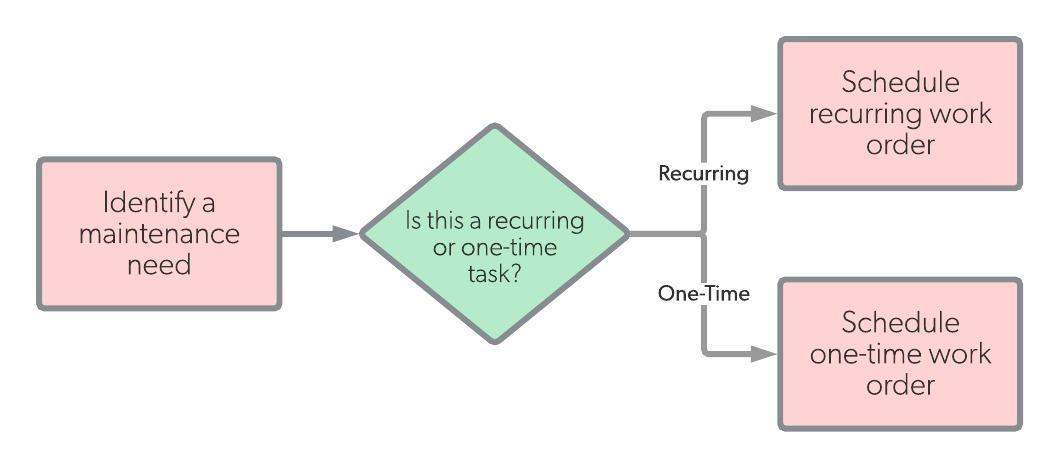Scheduled Maintenance
Scheduled maintenance is any repair and service work performed within a set timeframe. It details when given maintenance tasks are performed and by who. Scheduled maintenance may occur at repeating intervals or in response to a work request.
Scheduled Maintenance Workflow

Scheduled maintenance often occurs at repeating intervals, such as changing an air filter every March and September, or conducting a performance inspection at the start of each year. This kind of maintenance may also be used to fulfill a work order. Once a problem is discovered, a maintenance scheduler works with a maintenance planner to resolve the problem. A time is then scheduled to conduct necessary repairs.
In addition to managing the time at which maintenance tasks should occur, scheduled maintenance also deals with who performs those tasks. The time it takes for the job to be completed is compared with available work hours, which are factored into the schedule. The key here is to make sure those who should perform a given task are available to do so. Without coordinating a set time with maintenance workers and contractors, there is no guarantee that necessary work will be completed on time. This inevitably damages schedule compliance.
Scheduled Maintenance vs. Planned Maintenance
Scheduled maintenance is often lumped together with planned maintenance, but the two are actually separate endeavors. Planned maintenance deals with the processes and materials required to successfully complete needed work, whereas scheduled maintenance handles who performs the work and when.
The two go hand in hand, and they rely on one another to make sure maintenance tasks are completed in an efficient manner.
How Scheduled Maintenance Decreases Downtime
One of the goals of scheduled maintenance is to make sure time is used as efficiently as possible. It takes planned maintenance and determines when it should be conducted based on priority, available personnel, the systems requiring maintenance, and system locations. If multiple tasks are needed for a single piece of equipment, those are scheduled together.
Scheduled maintenance tasks, such as routine inspections, help detect minor problems before they develop into system failures. By adhering to a regular, well-designed maintenance schedule, maintenance technicians can detect problems early. This prevents lengthy unscheduled downtime and allows repair work to be conducted at optimal times. If these downtimes ever do occur, they're corrected without unnecessary delays.
In short, when repairs are necessary, careful maintenance scheduling makes sure they occur at a time that causes minimal disruption to the company’s operations.
Scheduled Maintenance Example
Most facilities have a heating, ventilation, and air conditioning (HVAC) system running throughout their buildings. This system requires regular inspections and tune-ups in order to keep running at optimum efficiency. Much of the work is fairly simple, such as keeping registers clean and replacing air filters at regular intervals.
Scheduled maintenance ensures those tasks are handled at specific times. When creating the schedule, either the maintenance planner or a designated scheduler determines when their technicians are available. If they're using the services of a third-party HVAC specialist, the specialist’s availability is also taken into account.
Scheduling may be complicated by additional work orders. For instance, if a piece of equipment near the facility’s heating system needs repairs, that work should be scheduled at a time either before or after the HVAC inspection, depending on priority. If the two tasks are scheduled for the same block of time, one could impede the other. This results in wasted hours and delayed maintenance work.
In many ways, scheduled maintenance may prevent future HVAC breakdowns. Suppose while performing the HVAC inspection, the assigned personnel discovers a faulty blower fan. A work order is created, and the repairs are then scheduled for a time in the near future before the issue causes further damage to the unit.
Benefits of Scheduled Maintenance
In addition to minimizing downtime, scheduled maintenance serves a variety of other purposes.
- Higher personnel utilization since maintenance workers spend more time working
- Increased asset life expectancy as breakdowns are prevented
- Lower maintenance costs as time is utilized efficiently and costly problems are prevented
- Culture of proactive efficiency as personnel perform needed tasks
- Reduced liability as assets are kept in safe working condition
The improved work culture, high cost-savings on asset maintenance, and increased workplace safety all speak for the efficacy of scheduled maintenance—at least when it’s handled properly. Scheduled maintenance is facilitated by the use of CMMS software and careful coordination with maintenance planning, both of which are well worth the investments of time and resources.
4,000+ COMPANIES RELY ON ASSET OPERATIONS MANAGEMENT
Leading the Way to a Better Future for Maintenance and Reliability
Your asset and equipment data doesn't belong in a silo. UpKeep makes it simple to see where everything stands, all in one place. That means less guesswork and more time to focus on what matters.


![[Review Badge] GetApp CMMS 2022 (Dark)](https://www.datocms-assets.com/38028/1673900459-get-app-logo-dark.png?auto=compress&fm=webp&w=347)
![[Review Badge] Gartner Peer Insights (Dark)](https://www.datocms-assets.com/38028/1673900494-gartner-logo-dark.png?auto=compress&fm=webp&w=336)
